Creating music samples with vinyl records
Music sampling has been done for years using different techniques. Currently samplers (either as a piece of hardware or as software) is the most extended tool for playing samples that can come from digital formatted music, live recording, vinyls or tapes. One of the most old techniques for sampling was cut&paste the audio tape. I love this video from Delia Derbyshire using reel-to-reel recording, creating loops by cut&pasting the audio tape, and sync the samples to create music.
Driven by my devotion for vinyls and analog processes (perhaps a bit of Dj wannabe too), and emulating the audio tape cut&paste technique, I tried to make the vinyl sampling a bit more analog – literally cut and paste pieces of vinyl to create samples.
I bought some second hand vinyl records, different music styles: Supertramp, Wagner, Paul Anka, Chicago, Lil Jon and some random ones to make the first tests. I spend a couple of hours browsing and listening to old records – I remember thinking “all projects should start like this”.
Back to the studio, I considered different options to cut the vinyls – it had to be a clean cut in order to minimize the resulting groove and therefore the stress on the stylus.
I first used a hot wire cutter – it took some time to set the right temperature so the wire cut but didn’t deform the vinyl. It was quite important to keep a constant speed to avoid undesired melting too. I cut a small sector with the idea of reversing it afterwards, so a song from Side A would have a sample from a song from Side B.
The piece fitted quite well in its natural position but not in its reverse position. I had to smooth it out with a file, but there was already a serious gap and V-shape groove pretty difficult to resolve.
So I jumped into the second attempt, using a blade. It took around 50 passes to cut one straight line.

I cut a radial sector, it was slightly better than the first trial (no melted material) but I had to remove a burr with a file and again, it created a tiny gap, big enough to scare the stylus.
Then I tried the laser cutter and things went better.
I made many tests to find the right laser power in order to get the cleanest cut possible. The best setting was to let the laser go through *almost* through the vinyl, and then crack manually the last thin layer (1). If the laser goes all the way through, it melts too much material and leaves a gap (2). If the laser doesn’t go enough deep, it’s pretty much impossible to take the piece out without creating an undesired crack (3).
Even if the laser is well calibrated, it always cuts creating a cone-shape cut. Using the first option the crack doesn’t take out any material or creates burrs on the bottom surface, so that surface is the one I used for playing the record afterwards. The top one always have a gap where the stylus would go in.
I made some tests with different sectors to analyze repeatability and the cut wasn’t totally consistent on different positions of the disc and even on different positions of a sector. I think it’s due to the difference in resolution of the laser head depending of the combinations of X and Y axis speeds.
These are sectors from the same record, already exchanged, seen from the laser cut side:
And this is seen from the bottom side, where the final layer is cracked. Aligning the surfaces properly the gap is almost not perceptible by the finger:
The first time I placed the record on the vinyl player for testing, I noticed that the sectors were too small and it was difficult to guess which sample was it. The transition wasn’t clean – when the stylus found the groove it created a low sound (similar than a bass drum).
I decided to cut larger sectors on different records and exchange them to create loops or tunes using samples from different albums. I cut these patterns:
I cut the same angle in the label area so after the sectors were exchanged, I can remember which samples contain every record.
I exchanged the sectors from 4 different records: Paul Anka, Supertramp, Lil Jon and Chicago. I selected these four from the once I bought since they have the same thickness (1,2mm). The pieces snapped pretty well on its new position but I secured them temporarily with tape, so I could adjust the height and make the surface as even as possible before playing the record.
This are some of the resulting albums:
I made a video containing part of the process and the result, playing the records in a vinyl player.
It’s possible to hear (and see) the the stylus jumping a little bit – that’s not good for the needle. However this bumps create a new beat over the unmatching beats of the two samples, and that helps to define a new rhythm. I thought about selecting specific samples and make them match perfectly but that would work only for one rotation, so it might be good for scratching but not for listening continuously – it’s quite difficult to find records that the beat corresponds with a revolution.
It’s been an interesting experiment with a really fun process. I knew it would be, having vinyls, music and lasers involved :)
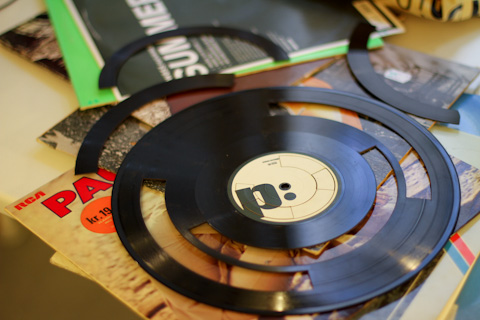
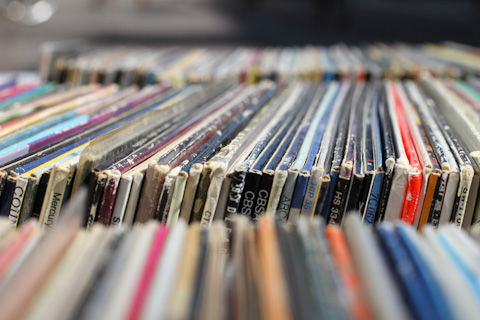



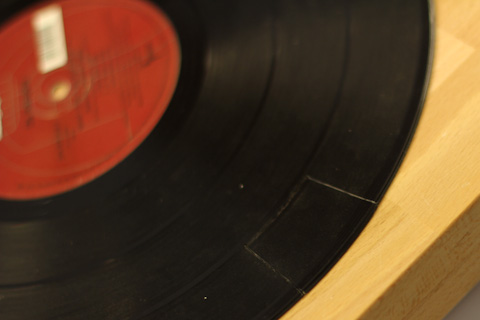



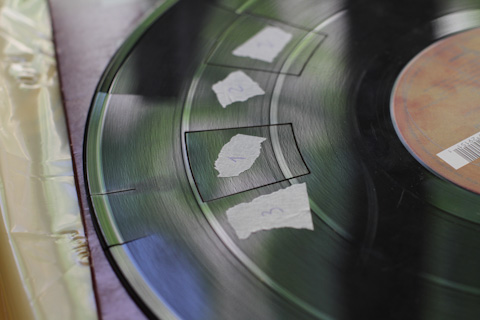

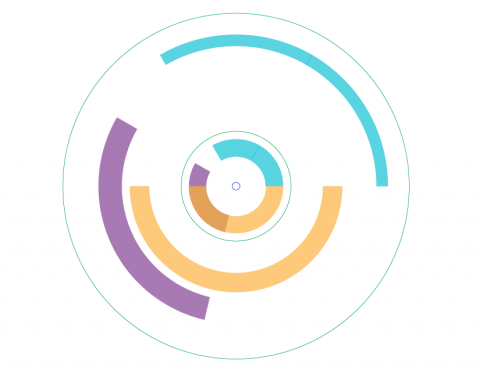








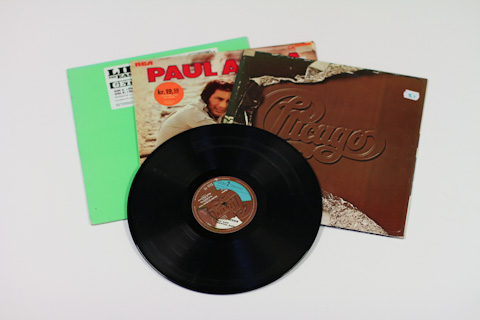


October 15th, 2011 at 3:35 am
Does Girl Talk know about this yet?
October 17th, 2011 at 7:45 am
[…] Nice That reports: Ishac Bertran has taken the world of audio sampling back a few decades to a time before music went digital. Using […]
October 27th, 2011 at 10:23 pm
VERY GOOD AT THE SAMPLES
October 30th, 2011 at 11:44 pm
[…] informações no Blog do Ishac-ac-ac-ac-ac-ac-ac-ac […]
November 2nd, 2011 at 6:16 am
Can you elaborate on the laser cutter you used? Not sure I know what one is, what it looks like, or where to get one! Thanks. Great post.
November 5th, 2011 at 3:28 pm
wow !
it remids me of my earlier experiences with records back in 1984.
this is the cover of the fsirts album 1989
http://www.actuellecd.com/fr/cat/am_017/
bonne journée
martin
November 12th, 2011 at 7:03 pm
[…] coffee, Walter’s piano, Walter’s mystery beatbox Analog vinyl sampling d’Ishac Bertran Dubstep Beatbox Dubstep : décryptage d’un phénomène musical chez MusikPlease Dubstep […]
November 17th, 2011 at 9:48 am
[…] Experimentation de sample modifié sur vinyle Par B.M. le nov 17, 2011 • 9 h 48 min Pas de commentaire Ishback Bertran expérimente la modification de vinyles pour créer des samples anlogiques. Il découpe et remplace certaines pièces du disque aux formes exactes ce qui crée des boucles et un changement de son lorsque l’aiguille suit les microsillons. Plus d’infos ici. […]
December 3rd, 2011 at 5:25 am
Nicely done! Always wanted to see something like this happen but without computer guided cutting it was just too iffy. Old pal Greg Fernandez used to do a much messier version which he called “flogging”, which goes like this:
January 4th, 2012 at 7:35 pm
Mate you have way, way too much time on your hands!
I’d rather be mixing with three decks!
January 5th, 2012 at 5:49 am
Ishac – my hat is off to you for taking on an awesome project like this. You’re like a modern day Jean Michel Jarre… this is incredibly inventive and while might not have resulted in exactly what you wanted the first time around, if you nailed it with a few records it could absolutely light up a party. Nice work!
January 8th, 2012 at 6:24 am
Very interesting. A mix of some vinyl art we can see (and buy) on the Net but with the sound. Redifinition of a musical puzzle.
January 8th, 2012 at 6:46 pm
Tu sei malato! Lasciatelo dire. E curati! Secondo me uno come te ha la nonna a tocchetti nel congelatore. E non vede una figa dal giurassico! Ripigliati!
January 9th, 2012 at 12:09 am
music library…
[…]ishback» Blog Archive » Creating music samples with vinyl records[…]…
January 9th, 2012 at 1:36 am
Music and Recording…
[…]ishback» Blog Archive » Creating music samples with vinyl records[…]…
January 30th, 2012 at 9:11 pm
This is simply impossible. It is impossible that you could cut the vinyl and align with those tools and that the needle does not skip. When you cut the vinyl with heat, melt the edges, you lose the continuity of the tracks and the needle jumps.
Neither do I think you can have synchronized the drums of both songs because we are talking about microscopic precision and you are using toy tools!
March 6th, 2012 at 8:04 pm
great, so cool ….
Technical question: what laser you used? what power? I am very interest to try this idea? thank you for answering me and I gave details. Greetings from Switzerland.
Steph
March 18th, 2012 at 3:00 pm
[…] recently came across a project by the multimedia artist Ishac Bertran who has developed an interesting way of making analogue remixes. In the post-mashup age of vinyl resurgence and exchange-shop excess, […]
May 15th, 2015 at 7:40 am
Christian Marclay has been doing this since the 80s, but not with the groove. Nice.